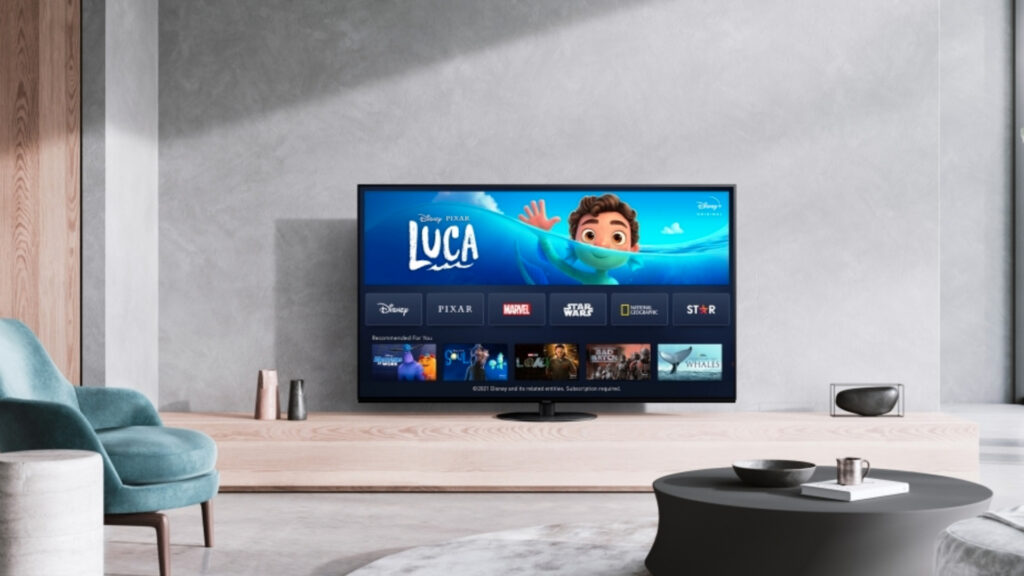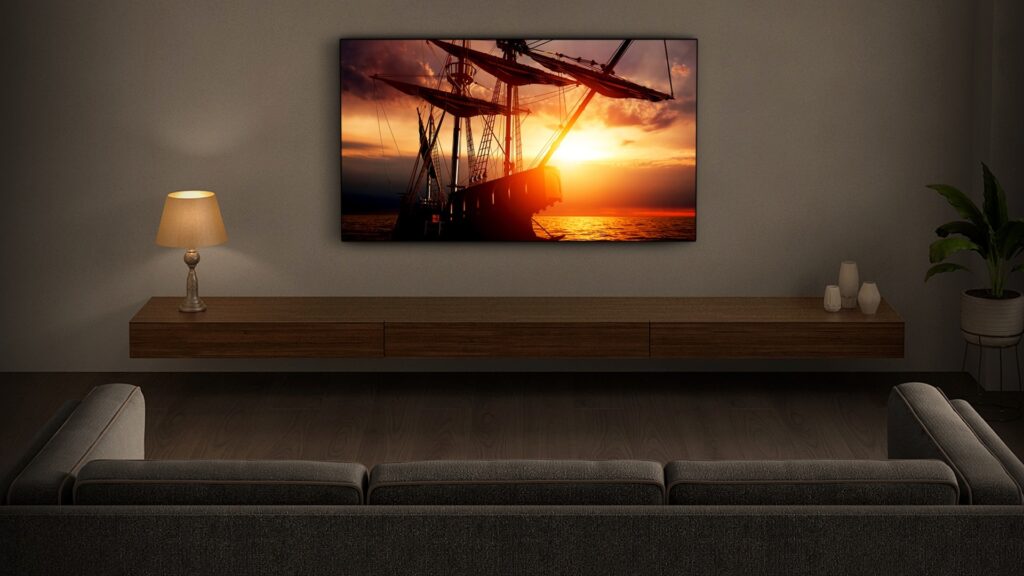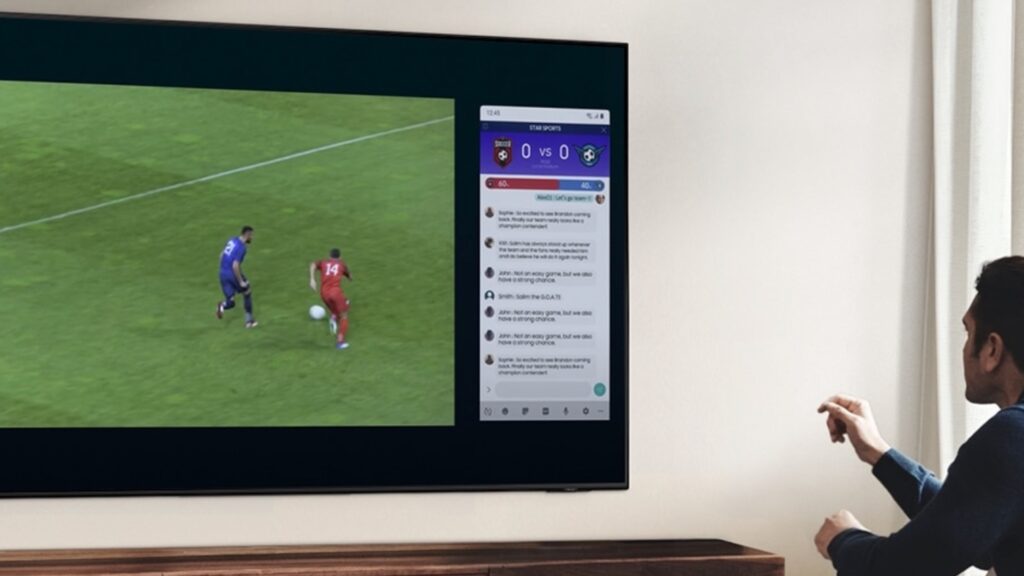The year 2022 will be punctuated by several sporting events, including a football World Cup. It may be a good time to change your television by opting for a 4K UHD model. Which are the best? Here is our selection.
The 4K UHD TV buying guide in a nutshell:
- OLED LG C2 (€1,189): the best, for all uses.
- Panasonic JZ1500 OLED (€1,390): for movie buffs, with a well-calibrated image.
- Sony X89K LCD (€899.99): proof that the LCD still has some nice remains.
- QLED Samsung Q80B (899 €): the best for video games.
We are in an even year, which means there will be a football World Cup. Small change for 2022: the disputed edition in Qatar will not take place this summer but this winter (because of the temperatures). Who says sports competition with a global reach, says want to change your television to enjoy it. This is all the more obvious since there are generally great promotions to encourage people to equip themselves. We therefore suggest that you take a little head start before admiring the prowess of Karim Benzema on the big screen.
In 2022, the references are multiple, the technologies too. More importantly, its choice may be dictated by its uses. Watching sports is one of them, but maybe some people prefer video games or movies. In any case, there is bound to be a product adapted to your needs and, if possible, to your wallet.
In this guide, you will find four televisions whose acquisition you will not regret.
The best 4K OLED TVs
LG C2
The years go by and look alike for LG, which never fails to renew its range of OLED televisions with ever more sophisticated references. In 2022, the C2 model is always pushing the limits of a technology that has quickly reached maturity. How ? By playing on the luminosity, which reaches even higher peaks. The result is vibrant HDR content, which also thrives on truly black blacks. Admittedly, LG’s hegemony may be shaken up a bit by the arrival of QD OLED televisions, but the first generation may be a bit too expensive for differences that the general public will struggle to grasp. This is what our test of the A95K model marketed by Sony confirmed: for 1,000 € more, the abyss is not sufficiently marked.
Proof of its versatility, the LG C2 has four HDMI 2.1 ports, is compatible with the HDR Dolby Vision format and sports a sober and elegant design (finally with a central foot to be compatible with narrower furniture). The C2 will display your video games, films and other series with impeccable accuracy, knowing that its home interface offers direct access to applications such as Disney+, Netflix or Amazon Prime Video or to options specifically designed for players. . Do you want even more brightness and an even more elegant design? Go for the G2.
Screen size: 42, 48, 55, 65, 77 and 83 inches. It can be found from €1,189.
Do you find the C2 too expensive? Know that the C1, reference of 2021, is still an excellent model. It is regularly found at unbeatable prices.

Panasonic JZ1500

Like the LG C2, the Panasonic JZ1500 is an OLED television. It is already the assurance of benefiting from a beautiful image, with perfect blacks, strong contrasts and ultra faithful colors. This reference will be aimed more readily at cinema lovers, Panasonic televisions being calibrated for the Seventh Art, the result of a more professional approach.
If you plan to devour series and films for long hours, the JZ1500 will be your best friend. In terms of colorimetry and image processing, this product is right at the top of the chain. Compared to the C2, we also gain compatibility with the HDR10+ format. The HZ1000 has only two minor flaws: only two HDMI 2.1 ports and a forgettable interface. The JZ2000, its replacement in 2022, should be even better.
Screen size: 48, 55 and 65 inches. It is available from €1,390.
The best LCD TVs
Sony X89K

In 2022, LCD technology continues to survive against more efficient OLED panels, but financially less accessible. And why should it disappear when we know that it offers the best brightness peaks (thanks to the backlight)? In this segment whose qualities are no longer to be proven, Sony offers very, very good products thanks to a certain know-how. As proof, its image processing is among the best on the market: it allows you to highlight the slightest content, even when the quality of the source is less good. We find this same finesse at Panasonic, with arguments that will appeal a little more to cinema lovers (thanks in particular to Dolby Vision).
Good news: the X89K specimen is HDMI 2.1 compatible, which will make it a good companion for the PlayStation 5 (if you manage to get your hands on Sony’s console) and makes it compatible with VRR functionality. For the ecosystem, the Japanese firm relies on Android and Google TV, which provides access to a rich and varied application portal and, above all, guarantees excellent ergonomics.
Screen size: 43, 50, 55, 65, 75 and 85 inches. It is available from 900 €.
Samsung Q80B

“Next-Gen gaming ready” can be read on a badge visible on the official Samsung website. As you will have understood, this Q80B has a clearly identified target. It must be said that the qualities of QLED technology are perfectly suited to gamers: vibrant colors, unparalleled brightness (1500 nits!) and a input lag very, very low.
Samsung adds to these features some popular features (gaming bar, AMD FreeSync Premium Pro, VRR, four HDMI 2.1 ports). We also appreciate Samsung’s home interface, which is more or less on par with Android TV in terms of available applications and ergonomics. Please note, Samsung ignores the Dolby Vision format, favoring HDR10+.
screen size : 50, 55, 65, 75 and 85 inches. It is found from 849 €.
Summary
| LG C2 | Panasonic LZ1500 | Sony X89K | Samsung Q80B | |
|---|---|---|---|---|
| Screen | LG C2OLED | Panasonic LZ1500OLED | Sony X89KLCD | Samsung Q80BLCD (QLED) |
| Dolby Vision | LG C2✅ | Panasonic LZ1500✅ | Sony X89K✅ | Samsung Q80B❌ |
| HDR10+ | LG C2❌ | Panasonic LZ1500✅ | Sony X89K❌ | Samsung Q80B✅ |
| HDMI 2.1 | LG C24 | Panasonic LZ15002 | Sony X89K2 | Samsung Q80B4 |
| Sizes | LG C242, 48, 55, 65, 77 and 83 | Panasonic LZ150048, 55 and 65 | Sony X89K43, 50, 55, 65, 75 and 85 | Samsung Q80B50, 55, 65, 75 and 85 |
The criteria to take into account before choosing your 4K TV
OLED versus QLED: which to choose?
On the television market, two technologies are opposed: OLED, popularized by LG, and LCD, whose QLED evolution is supported by Samsung. On the one hand we have pixels capable of emitting their own light, which guarantees immense contrasts (with really black blacks). On the other, we have a TV that still needs a backlight. OLED and QLED each have their advantages, but in our opinion, OLED is clearly the best.

What is mini LED?
The mini LED is the latest evolution of the LCD. It is always a question of diffusing the light with a backlight bringing together several LEDs. Here, they are even smaller, which makes it possible to put more of them in order to better refine the diffusion of light. It’s the technology that powers the latest iPad Pro and Samsung’s Neo QLED TVs. As we have seen in our tests, the progress is appreciable, but there are still a few flaws to report.

What is QD-OLED?
QD-OLED is an evolution of OLED, whose panels are designed by Samsung Display. The Korean manufacturer, which has long shunned the technology favored by LG – its neighbor and rival – wants to correct its biggest flaw: brightness. Both technologies rely on pixels capable of emitting their own light. On the other hand, the structure of the panels is different: the OLED panels are based on a white light at the source which will pass through RGB filters (red, green, blue) to produce different colors, while the QD-OLED panels s rely on a source of blue light that passes through nanoparticles to produce different colors. The absence of filters makes it possible to gain in luminosity. In 2022, there are only two models released — Samsung S95B and Sony A95K — and neither hits the promised numbers (1,500 nits of power). In short, let’s wait for the next generation.

Do I need a specific HDMI cable for the 2.1 standard?
The HDMI 2.1 standard will gradually become standard because of all the formats and functionalities it allows (this is especially true for gaming) – as long as all your devices are compatible. To transmit a large amount of data, it is necessary to have a cable capable of supporting them. This does not mean that you will have to spend tens of euros for an HDMI cable: an Ultra High Speed model (48 Gbits / s) will do the trick.

What size 4K UHD television should I choose?
Whether we like it or not, the television market today revolves around 55 and 65 inch sizes. The 4K definition, coupled with technologies that are less and less tiring for the eyes, makes it possible to increase the display, without having to move back your sofa. As the reading distance decreases, one can buy larger without hurting their eyes. The recommended distance varies according to the manufacturers: between 1.5 and 2 times the height of the television. In practice, this gives the following example: you can place an 85-inch screen 2 meters from you without any problem. In short, do not hesitate to go to the size above. Note that OLED televisions do not exist below the 42-inch diagonal.
Should motion compensation be disabled?
Manufacturers tend to wrap their televisions with ever more advanced algorithms, supposed to provide a better quality image. However, they often tend to distort the rendering. The symbol of this drift is called motion compensation, designed to make the image more fluid. Filmmakers hate this technology. And us too, even if it tends to be more and more efficient.
Should you fall for an 8K TV?
8K televisions have already been available for several years. But the question still arises of their interest when easily accessible 8K content is very, very rare. We will remember one thing: 8K models are exceptional 4K televisions, but much more financially inaccessible. In short, we will always recommend a 4K specimen.
The links in this article are affiliated: if you find your happiness thanks to us, we receive a small commission. We’ll explaine everything here.
